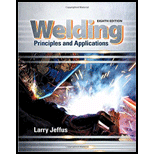
Bundle: Welding: Principles and Applications, 8th + MindTap Welding, 4 terms (24 months) Printed Access Card
8th Edition
ISBN: 9781337219426
Author: Larry Jeffus
Publisher: Cengage Learning
expand_more
expand_more
format_list_bulleted
Concept explainers
Textbook Question
Chapter 15, Problem 5R
In Practice 15-3, what size should the root face be?
Expert Solution & Answer
Want to see the full answer?
Check out a sample textbook solution
Students have asked these similar questions
Only question 2
Solve for the support reactions at A and B.
C
3 kN/m
B
-1.5 m-
-1.5 m 1.5 m-
1.5 m-
4. Solve for the support reactions at A and B.
W1 600 lb/ft
W2 150 lb/ft
A
B
Chapter 15 Solutions
Bundle: Welding: Principles and Applications, 8th + MindTap Welding, 4 terms (24 months) Printed Access Card
Ch. 15 - How are the sheet steel workmanship samples tested...Ch. 15 - What size are the fillet welds in Practice 15-2?Ch. 15 - How should the welds be cleaned on workmanship...Ch. 15 - What is the acceptable undercut on workmanship...Ch. 15 - In Practice 15-3, what size should the root face...Ch. 15 - How wide of an area should be cleaned on the plate...Ch. 15 - What is the root opening for the butt joints in...Ch. 15 - How is the 1 in. diameter hole cut in the...Ch. 15 - According to Figure 15-15, how are the test...Ch. 15 - According to Practice 15-6, after each weld pass...
Ch. 15 - What is the bevel angle for the test plates in...Ch. 15 - What type of groove is required for 2G butt welds?Ch. 15 - What weave pattern is used for the cover pass on...Ch. 15 - How can slag be cleaned off of FCAW-G and FCAW-S...Ch. 15 - Prob. 15RCh. 15 - What shielding gas mixture and flow rate are...Ch. 15 - What is the maximum interpass temperature for...Ch. 15 - What is the maximum allowable undercut for a...Ch. 15 - What shielding gas mixture and flow rate are...Ch. 15 - What are the maximum acceptance criteria for bend...Ch. 15 - According to Table 15-4, what is the range of...
Knowledge Booster
Learn more about
Need a deep-dive on the concept behind this application? Look no further. Learn more about this topic, mechanical-engineering and related others by exploring similar questions and additional content below.Similar questions
- In cold isostatic pressing, the mold is most typically made of which one of the following: thermosetting polymer tool steel sheet metal textile rubberarrow_forwardThe coefficient of friction between the part and the tool in cold working tends to be: lower higher no different relative to its value in hot workingarrow_forwardThe force F={25i−45j+15k}F={25i−45j+15k} lblb acts at the end A of the pipe assembly shown in (Figure 1). Determine the magnitude of the component F1 which acts along the member AB. Determine the magnitude of the component F2 which acts perpendicular to the AB.arrow_forward
arrow_back_ios
SEE MORE QUESTIONS
arrow_forward_ios
Recommended textbooks for you
 Welding: Principles and Applications (MindTap Cou...Mechanical EngineeringISBN:9781305494695Author:Larry JeffusPublisher:Cengage Learning
Welding: Principles and Applications (MindTap Cou...Mechanical EngineeringISBN:9781305494695Author:Larry JeffusPublisher:Cengage Learning Precision Machining Technology (MindTap Course Li...Mechanical EngineeringISBN:9781285444543Author:Peter J. Hoffman, Eric S. Hopewell, Brian JanesPublisher:Cengage Learning
Precision Machining Technology (MindTap Course Li...Mechanical EngineeringISBN:9781285444543Author:Peter J. Hoffman, Eric S. Hopewell, Brian JanesPublisher:Cengage Learning Understanding Motor ControlsMechanical EngineeringISBN:9781337798686Author:Stephen L. HermanPublisher:Delmar Cengage Learning
Understanding Motor ControlsMechanical EngineeringISBN:9781337798686Author:Stephen L. HermanPublisher:Delmar Cengage Learning

Welding: Principles and Applications (MindTap Cou...
Mechanical Engineering
ISBN:9781305494695
Author:Larry Jeffus
Publisher:Cengage Learning

Precision Machining Technology (MindTap Course Li...
Mechanical Engineering
ISBN:9781285444543
Author:Peter J. Hoffman, Eric S. Hopewell, Brian Janes
Publisher:Cengage Learning

Understanding Motor Controls
Mechanical Engineering
ISBN:9781337798686
Author:Stephen L. Herman
Publisher:Delmar Cengage Learning
Understanding Torsion; Author: The Efficient Engineer;https://www.youtube.com/watch?v=1YTKedLQOa0;License: Standard YouTube License, CC-BY